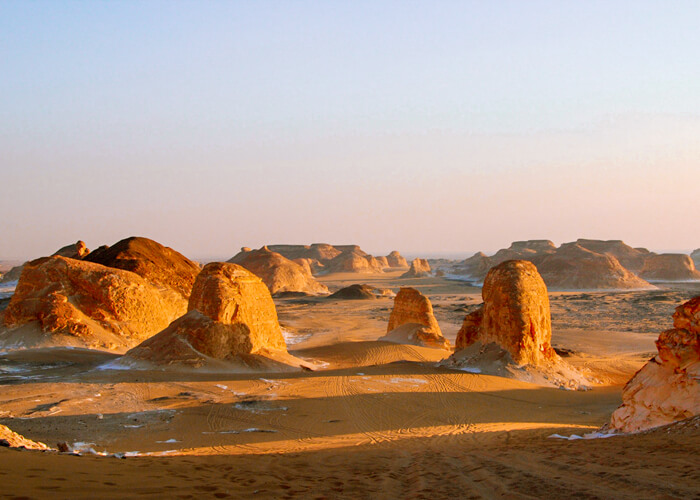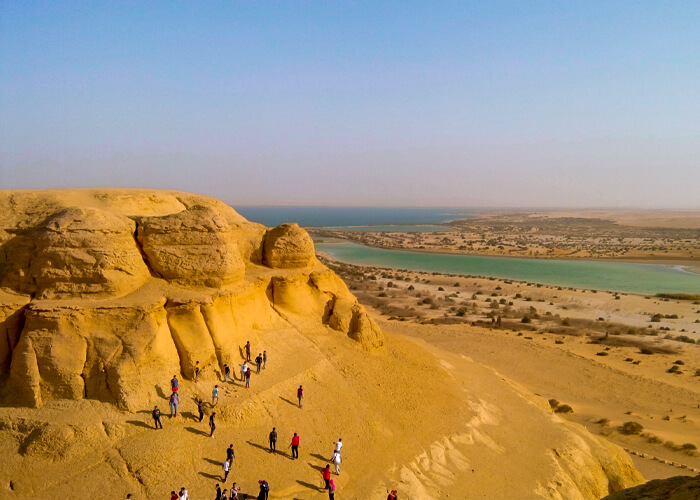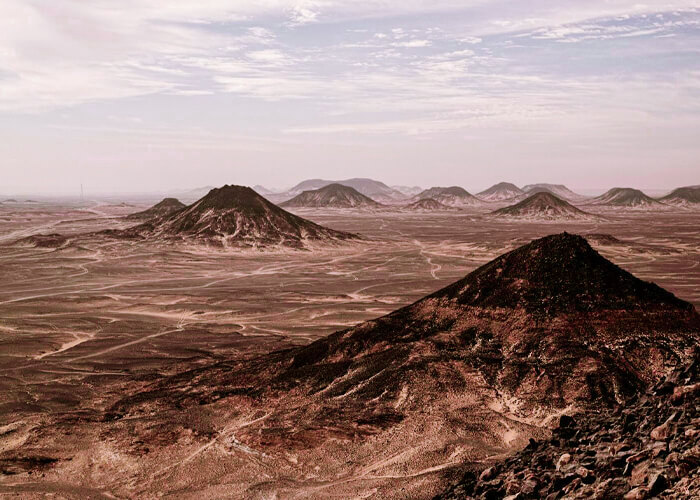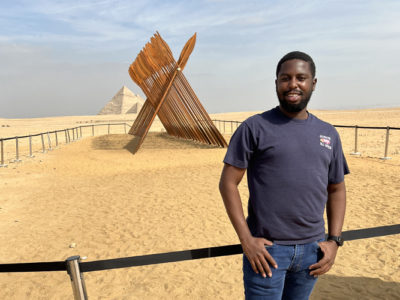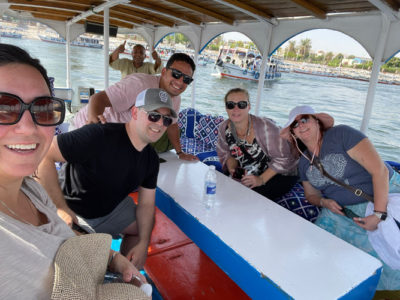Egypt Oases provides practical information when traveling through these regions, including the Valley of El Heiz, the Western Desert in Egypt, and the amazing wonders of sand baths and swimming in the sulfur-rich waters of hot springs. The journey through the Egyptian desert is divided into two main parts: the deep and vast desert and oases, havens of peace and vegetation where life appears like magic. Each oasis is located in a depression in the terrain and can be thousands of kilometers long. In the Western Desert of Egypt, far from the Nile Valley, a series of oases emerge as small green groves that have had enormous strategic value since Pharaonic times. Oases of a general nature, and many in particular. Places of peace, where time stands still like nowhere else in this interconnected world. Places where you can feel the warmth of its people, where they stop to talk with the simple purpose of being friendly.
Check top Egypt Oases
Bahariya Oasis
Today we will talk about one of the most important semi-engineered constructions of the twentieth century. This is the Aswan...
Read moreSiwa Oasis
Today we will talk about one of the most important semi-engineered constructions of the twentieth century. This is the Aswan...
Read moreEl Kharga Oasis
El Kharga Oasis is located approximately 200 kilometers west of the Nile in the southern section of Egypt's Western Desert....
Read moreEl Dakhla Oasis
The Dakhla Oasis, which is situated 189 kilometers west of Kharga and has more than 600 natural springs and lakes,...
Read moreWhite Desert
Today we will talk about one of the most important semi-engineered constructions of the twentieth century. This is the Aswan...
Read moreFarafra Oasis
Farafra is in the west of Egypt, between the oasis of Dakhla and the oasis of Bahariya. It is 180...
Read moreEl Fayoum Oasis
The Fayoum Oasis is one of Egypt's most famous oasis areas and is often called "Faiyum Egypt." You can read...
Read moreBlack Desert
It takes about four to five hours from Cairo to the Black Desert. It's a popular place for tourists who...
Read moreEgypt’s oases appear out of nowhere in the middle of the harsh Desert, and Herodotus gave them the name “Holy Isles,” which shows how much they always have interested people. In this section, we’ll tell you what oases are in Egypt, where they are, and, most notably, what you can do there for your trip. Our agency will be in charge of making a custom travel plan for you. You can visit several of them or stay in one of them, which will give you a place to start exploring other exciting places in the area.
At the moment, the oases of Egypt look like islands of greenery in the middle of a desert. This wasn’t always the case, though. Not exactly, at least. Back thousands of years ago, the area that is now a desert was more like a savannah. There were often springs and streams of water, and it rained constantly. But as the climate slowly warmed, the area became very dry, and almost all the water on the surface disappeared. But important aquifers stayed underground, popped up naturally in some places, and were used by people through wells because the land was porous.
In a place that was so dry, the oases of Egypt stayed on green islands where people of all sizes lived. Even though the living conditions may have seemed challenging, they sometimes had a lot of money. This is because they needed the desert nomads’ caravans very much and had to stop in them on their long journeys. In the oases, people also did brokerage and deposit work, which gave them more room to move and made it easier to take advantage of the people who lived there.
In real old Egypt, there were “gas stations” here! Today, these roads are based on the network of roads connecting Egypt’s oasis towns and some stops that were sometimes required on expeditions that the pharaohs planned. People looked for things like gold, ebony, ivory, and precious metals in them. It is always scheduled with the location of Egypt’s oasis towns.
Egypt’s oases were also crucial from a geostrategic point of view, especially those in the Western Desert, which is also called the Libyan Desert. This is because it was a complete border with its neighbors to the west, the Hyksos. As it turned out, they were a real threat because they could take over the country in the Second Intermediate Period.
Because of all of these things, the oases in Egypt were never independent and were never thought of as “foreign” lands. Instead, they were always under the control of the pharaohs. The central government told them what to do when the capital was in Thebes or Memphis in the early days of the Old Kingdom. Then, when they reached the Middle Kingdom, they had their leaders, but they were always under the control of the capital city, Thebes (now Luxor).
On the other hand, because they were far away and hard to get to, the oases of Egypt were seen as the perfect places to send people who were against the pharaohs. Some of these cases have been recorded. People still “exile” themselves today, but in a very different way: traveling to the oases of Egypt is an unbeatable way to get away from the stresses of everyday life and find the peace that people long for during the holidays.
Egypt Western Desert
Because of how the land is shaped, we will visit several connected oasis towns like links in a chain. Some of the oasis towns you could see on your trip are Bahariya, Siwa, Fayoum, Dakhla, El Kharga, and Farafra. The Black Desert and the White Desert are the last two deserts you shouldn’t miss.
Egypt vacation packages can vary quite a bit, so it’s important to consider several things before choosing one.

We Are Travel Agency
Amon Ra Tours, Egypt’s travel experts, offer private, tailor-made tours, for families, small groups, and retreats. Get immersed in the Egyptian culture and history while receiving new perspectives from locals. When you book with us, you become family.
Our staff holds a plethora of not only historical knowledge, but day-to-day living to make your trip memorable.
WE HELP YOU PLANNING YOUR JOURNEY
| Trust and Safety | Beautiful Places |
| Best Travel Agent | Passionate Travel |
| Best Price Guarantee | Fast Booking |
Frequently Asked Questions.
Egypt Oases are places that provide a variety of plant life, as well as shade and water.
There are close to seven oases in Egypt’s western and eastern deserts, where the weather is arid all year, and Bedouin tribes have lived for many generations.
Visitors to Egypt must enter with a passport valid for at least (6) months from the date of arrival. Most nationalities can have an entry visa valid for one (1) month from the date of arrival. Some of these countries are Australia, Canada, South Korea, Croatia, the United States, Georgia, Japan, Macedonia, Norway, New Zealand, European Union, Ukraine, the United Kingdom, Russia, Serbia, and most Latin American countries. This visa is acquired at the window before going through customs.
Since your tour guide will be a Spanish-speaking professional, it is not essential. However, it is beneficial to learn some of the most commonly used words and phrases. In case you wish to have contact with the locals and explore popular places, it will be necessary for you to know a few words.
While it is true that Egypt has a wealth of fascinating historical sites, the Nile River is not far behind. Aboard a cruise, you can experience navigating one of the most famous and history-filled rivers while watching the most beautiful sunsets that only Egypt has to offer. This is an experience like no other.
Taking pictures is allowed in most of the places to visit, however, some of these sites charge an additional fee for allowing you to do so. In some museums, it is forbidden to take pictures.
With a relatively low crime rate, especially in places that tourists visit frequently. Egypt is and has been one of the best and safest tourist destinations for decades. With the quality of hospitality of the locals, you will feel at home in Egypt. However, as in any other tourist destination, it is important to take into account and follow the recommendations provided by your travel agency in order to explore and enjoy the country at ease.
Amon Ra Tours is one of the most recognized and professional travel agencies in the tourism industry in Egypt. We offer a wide range of benefits, options, and services to our clients. On every trip, we make sure that your experience is unique, enjoyable and never to be forgotten. To this end, we have programs and itineraries that are competitively priced in the market and fully tailored to the needs and tastes of travelers to create a personal experience like no other. In addition, to fully ensure that your trip is unforgettable and the experience exceeds your expectations, you will have a great customer service team and a professional tour guide to accompany you on your tour. For your comfort, you will enjoy first-class accommodations and much more.
There are a lot of activities that you can do on your trip to Egypt. However, the favorites of travelers are: visit the pyramids, tour the old Cairo visiting the most emblematic places (mosques, streets, markets, etc), sailing aboard a cruise on the Nile River. Visiting and touring other cities in Egypt.
Amon Ra Tours offers several types of packages, among these, are Classic tours, in which you will explore both Cairo and the south of the country aboard a cruise ship. Tours to Egypt in 5 days where you will explore the best of the country. Cruises on the Nile, while you get to know various places.
Combined tours to the Middle East with countries such as the Arab Emirates, Jordan, and Turkey. Different tours to explore various Egyptian cities and special trips organized for Easter and Christmas.






